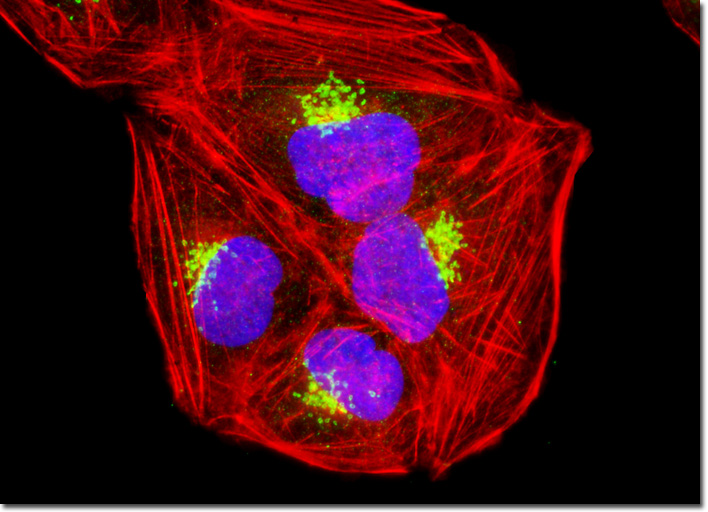Fluorescence Digital Image Gallery
Human Bone Osteosarcoma Cells (U-2 OS)
|
Hoechst 33342 is a classic blue-fluorescent counterstain. Similar to the other Hoechst dyes, the probe preferentially binds to AT-rich base pair clusters in the minor groove of double-stranded DNA. When in the bound state, Hoechst 33342 experiences a substantial increase in fluorescence intensity, which is associated with the displacement of water molecules. When unbound, the dye's spectra are pH dependent, exhibiting a much higher fluorescence quantum yield at pH 5 than at pH 8. The fluorophore is quite soluble in water and is cell membrane permeant. Hoechst 33342 may be stimulated by the 351-nanometer spectral line of high-power argon-ion lasers or the 354-nanometer line from a helium-cadmium laser, as well as by mercury and xenon arc-discharge lamps. To create the digital image above, a healthy log-phase culture of human osteosarcoma cells was fixed, permeabilized, and blocked with 10-percent normal goat serum in phosphate-buffered saline prior to immunofluorescent labeling with rabbit primary antibodies to giantin. The culture was subsequently stained with a mixture of goat anti-rabbit secondary antibodies conjugated to Alexa Fluor 488, in order to visualize the giantin, and Alexa Fluor 568 conjugated to phalloidin for the filamentous actin cytoskeleton. Hoechst 33342 was used to visualize the nuclei. Images were recorded in grayscale with a QImaging Retiga Fast-EXi camera system coupled to an Olympus BX-51 microscope equipped with bandpass emission fluorescence filter optical blocks provided by Omega Optical. During the processing stage, individual image channels were pseudocolored with RGB values corresponding to each of the fluorophore emission spectral profiles. |
© 1995-2025 by Michael W. Davidson and The Florida State University. All Rights Reserved. No images, graphics, software, scripts, or applets may be reproduced or used in any manner without permission from the copyright holders. Use of this website means you agree to all of the Legal Terms and Conditions set forth by the owners.
This website is maintained by our
|
